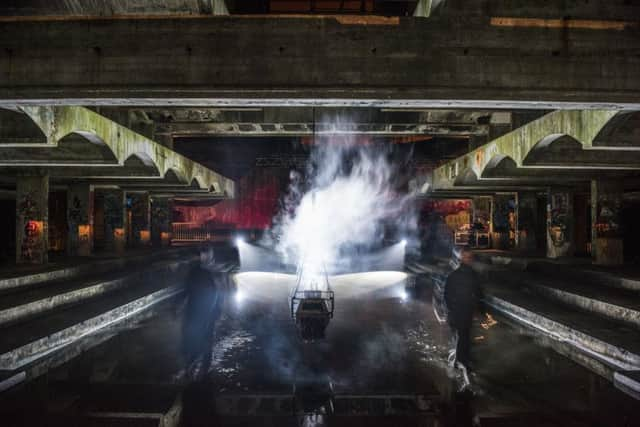Roamer: Hinterland celebrates innovation, architecture and design in Scotland


News Letter readers of a certain age may remember the ‘happenings’ that were held, mostly in America, in the 1960s.
They were performances, events or ‘situations’, with music, movement, drama and not a little ‘organised mayhem’, defined by the critics as ‘performance art’.
Roamer attended a small happening in Belfast in 1971.
Advertisement
Hide AdAdvertisement
Hide AdIt was called ‘The Tomato Sonata’, performed by a group of musicians wearing face-masks who made their entrance on bicycles and sat on top of a huge, pneumatic tomato, playing rock music and reciting poems.
Roamer is on the bonnie bonnie banks of Loch Lomond this week, and in Glasgow, and on the Isle of Lewis, and in Edinburgh, and at a few other locations that are connected with YIAD, which will be explained in a moment!
I recently received a kind invitation from the Visit Scotland tourism organisation to pop over and savour a few days and events from their Year of Innovation, Architecture and Design, called YIAD 2016.
YIAD runs until the end of December, but Roamer’s report begins with an extraordinary event that launched YIAD’s Festival of Architecture.
Advertisement
Hide AdAdvertisement
Hide AdThe event was called Hinterland, at St Peter’s Seminary, Cardross, near Helensburgh on the River Clyde, west of Glasgow.
Hinterland was like a 1960s happening, except that it was poignant, thought-provoking, endearing, moving - and completely different to any other ‘performance’ that I’ve ever attended.
Abandoned in the 1980s, St Peter’s Seminary is hailed as “a perfect example of modernist architecture in Scotland.”
Many of its thick, unyielding, reinforced-concrete walls are today covered with starkly coloured graffiti; water drips through gaping roofs; floors cantilever nervously over rocks and steps and corridors are open to the elements.
Advertisement
Hide AdAdvertisement
Hide AdBut the derelict building retains overwhelming hints of its past life as a religious institution.
Tiny rooms are honeycombed together where solitary, trainee-priests pondered their vocation, prayed their prayers and studied their religious tomes.
Corridors lead to larger spaces for communal gatherings. Winding tunnels of stone curve towards further corners and echoing, concrete cavities.
“See it transformed in Hinterland,” said Roamer’s enticing invitation to YIAD.
Advertisement
Hide AdAdvertisement
Hide AdHeld nightly until March 27, Hinterland is a mind-boggling, multi-experience world-premiere that stars this massive, sprawling, soaring, dilapidated seminary set amidst dense, undulating forest.
The event combines moving lights that pierced, played and danced with the darkness, all set to a haunting choral and orchestral soundscape that emerged from trees, tunnels and concrete voids, from above, from beside, and from all around the mesmerized spectators.
Busloads of folk who’d answered the call to this amazing launch of Scotland’s architectural celebration weaved in high-revving relays through the dark, tree-lined country roads, upwards through the hills to the derelict seminary building, set in the midst of the Kilmahew Estate in Argyll and Bute.
St. Peter’s was opened in 1966 but only served its function as a training-centre for an annual intake of about 100 would-be Roman Catholic priests for 13 years.
Advertisement
Hide AdAdvertisement
Hide AdFor the past eight years, the Glasgow-based public arts organisation NVA has been raising money to make the remnants of St Peter’s safe for performance art and for all sorts of exhibitions, conferences and community events. NVA is an acronym of ‘nacionale vita activa’, expressing the ancient Greek ideal of a lively democracy, where actions and words shared among equals bring new thinking into the world.
Angus Farquhar, NVA’s creative director, said “It’s a miracle that the Seminary was ever built.”
He referred to its “distinctive zig-zag design and internal features such as vaulted ceilings and floating staircases.
Hinterland,” Angus explained, “is almost a walk-through sculpture!”
Advertisement
Hide AdAdvertisement
Hide AdSince it was deconsecrated in 1980 the building has become degraded by fire, rain and vandalism, but it still regularly attracts visiting architecture students and aficionados from around the world.
Hidden from the nearby Clyde Estuary by the forest of Kilmahew, like a vast, concrete setting for a sci-fi or apocalyptic movie, the night-time audience - and Roamer - disembarked from their buses and were given ‘walking poles’ tipped with neon torches.
We were part of the whole creative experience, snaking through the darkness to the ruined seminary buildings, as if on a pilgrimage, getting closer to the haunting music coming from within the concrete spaces once inhabited by trainee priests.
The specially commissioned choral recording by composer Rory Boyle was carried through hidden loudspeakers, hauntingly performed by St. Salvator’s Chapel Choir from the University of St Andrews.
Advertisement
Hide AdAdvertisement
Hide AdAngus Farquhar explained “the subtle composition of lighting, projection and choral music beautifully echoes the site’s history and will give audiences a strong impression of its creative potential. I’m very much looking forward to seeing how people respond to it,” he added.
Architecture in Scotland is both wonderful and diverse. Across the country are countless structures built in varying styles and eras, including Gothic, Renaissance, Georgian, Victorian, art nouveau, art deco and modern.
Roamer is here for a few more days and will be visiting many special buildings and telling a few of their stories, but today he’s pondering, as are many other privileged visitors, the amazing experience that was Hinterland.
“Hinterland is like a visit to a temple of post-apocalyptic religion,” said a reviewer, adding “it is also a memorable celebration of the enduring beauty of a derelict architectural masterpiece.”
More about YIAD on Friday’s page. Full details about Hinterland and the whole 2016 programme are on www.visitscotland.com